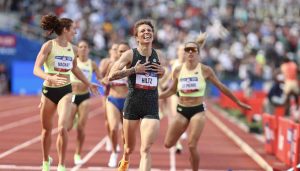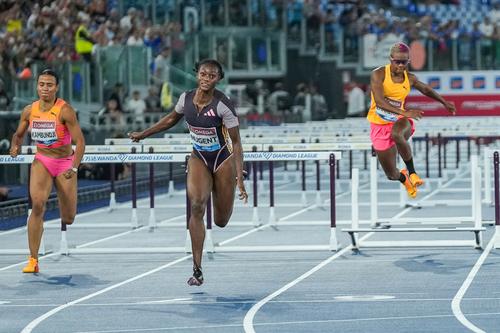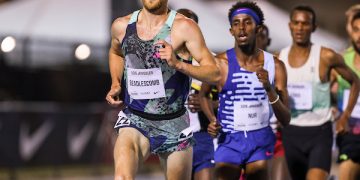Many people in our sport watch the Grand Slam Track series, whose releases on thirty different RACERS have created a stir like few others! Deji Ogeyingbo sent us this piece as athletes 19 and 20 were being named, but his theme rings true.
What Grand Slam Track is doing via social media, athlete interviews, and fun posters is getting noticed. We will watch as they name the final eighteen racers and the 48 challengers.
How will Grand Slam Track continue to build interest in its brand?
Grand Slam Track Faces Tough Challenge as It Rounds Out Its Star-Studded Roster
The new Grand Slam Track (GST) event, with Michael Johnson as its founder set to launch next year, has taken the track and field world by storm, signing some of the most prominent names in the sport. But even with all the star power, maintaining that elite talent level might be more complex. As GST announced its 19th and 20th athletes —Ackera Nugent and Roshawn Clarke—they’ve completed the women’s short hurdles group, adding a final piece to an impressive roster. (Editor’s note: GST has now named athletes 21-30!).
For a company whose tagline is “only the fastest,” they’ve mostly lived up to the hype. GST’s roster includes Olympic and World Championships medalists and athletes like Sydney McLaughlin-Levrone, Fred Kerley, and Jasmine Camacho-Quinn. These athletes have proven they can compete on the biggest stages and win. However, as GST continues to expand its roster, some recent signings have raised questions about whether they can sustain this excellence long-term.

Track and field are competitive, and while GST wants to keep signing top-tier athletes, it is starting to push the limits of who it can sign. For example, Nikki Hiltz, who finished 7th in the 2024 Paris Olympics in the 1500m, is one of the few athletes on its roster who didn’t finish in the top four in a recent global competition. While Hiltz secured a World Indoor silver, her signing slightly deviated from GST’s initial all-medalist approach.
The challenge is clear: To stay “only the fastest,” GST must keep bringing in athletes who consistently finish in the top four at World Championships or Olympic Games. But there are only so many top-tier athletes available, and the competition to sign them is fierce. Track and field doesn’t have the same roster flexibility as a team sport. There are only four spots in each event group, which makes it challenging to keep signing fresh talent without bumping someone off the list.
Nugent, for instance, finished 5th at the 2023 World Championships in the 100m hurdles and didn’t finish in the Olympic final. While Clarke finished 4th in the 400m hurdles at the 2023 World Championships, he’s still searching for his first medal. These are still elite athletes, but with every signing of a 5th or 6th place finisher, GST moves away from that ideal roster of only top-four finishers.

And then there’s the financial reality. Signing the very best of the best comes at a cost. These athletes aren’t cheap, and with more elite runners to pay, the expenses add up fast. The money involved in sustaining a team of medalists is enormous; at some point, GST will have to face the music. As The Rolling Stones once sang, “You can’t always get what you want.” They want the fastest, but the deeper they enter the global talent pool, the harder it becomes to lock in those top names.
There is the challenge of keeping athletes happy. Many of these track stars are used to being the face of their brand or team. But with so many big names on one roster, egos can clash, and managing those relationships is no small feat. After all, when you have multiple athletes in the same event, someone will be the Number two, and only some are comfortable with playing second fiddle.
The excellent news for GST is that, even with these obstacles, they’re still signing some of the biggest names in the sport. Completing the women’s short hurdles group with athletes like Masai Russell, Cyrena Samba-Mayela, and Camacho-Quinn gives them a formidable lineup for their inaugural season. The short hurdles may be their first event group to fill up, but other events, like the long hurdles and sprints, are not far behind.

Ultimately, GST’s success will depend on its balance of star power, strategic signings, and intelligent financial planning. Right now, they’re at the top of the game (in terms of publicity and branding), but the question remains—can they stay there? The first year will surely give more insight. Will they keep their “only the fastest” mantra alive in a sport where talent is plentiful but accurate elite talent is rare? It’s not perfect, but we are watching.
Author

Deji Ogeyingbo is one of Nigeria’s leading Track and Field Journalists as he has worked in various capacities as a writer, content creator, and reporter for radio and TV stations in the country and Africa. Deji has covered varying degrees of Sporting competitions within and outside Nigeria which includes, African Championships and World Junior Championships. Also, he founded one of Nigeria’s leading Sports PR and Branding company in Nikau Sports in 2020, a company that aims to change the narrative of how athletes are perceived in Nigeria while looking to grow their image to the highest possible level.
View all posts






















